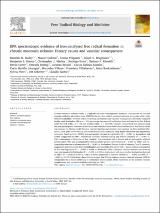Mostrar el registro sencillo del ítem
EPR spectroscopic evidence of iron-catalysed free radical formation in chronic mountain sickness : dietary causes and vascualr consequences
| dc.contributor.author | Bailey, Damian M | |
| dc.contributor.author | Culcasi, Marcel | |
| dc.contributor.author | Filipponi, Teresa | |
| dc.contributor.author | Brugniaux, Julien V | |
| dc.contributor.author | Stacy, Benjamin S | |
| dc.contributor.author | Marley, Chistopher J | |
| dc.contributor.author | Soria, Rodrigo | |
| dc.contributor.author | Rimoldi, Stefano F | |
| dc.contributor.author | Cerny, David | |
| dc.contributor.author | Rexhaj, Emrush | |
| dc.contributor.author | Pratali, Lorenza | |
| dc.contributor.author | Salinas Salmón, Carlos | |
| dc.contributor.author | Murillo Jáuregui, Carla | |
| dc.contributor.author | Villena, Mercedes | |
| dc.contributor.author | Villafuerte, Francisco | |
| dc.contributor.author | Rockenbauer, Antal | |
| dc.contributor.author | Pietri, Sylvia | |
| dc.contributor.author | Scherrer, Urs | |
| dc.contributor.author | Sartori, Claudio | |
| dc.date.accessioned | 2022-05-25T19:41:25Z | |
| dc.date.available | 2022-05-25T19:41:25Z | |
| dc.date.issued | 2022 | |
| dc.identifier.uri | http://repositorio.umsa.bo/xmlui/handle/123456789/28381 | |
| dc.description.abstract | Abstract Chronic mountain sickness (CMS) is a high-altitude (HA) maladaptation syndrome characterised by elevated systemic oxidative-nitrosative stress (OXNOS) due to a free radical-mediated reduction in vascular nitric oxide (NO) bioavailability. To better define underlying mechanisms and vascular consequences, this study compared healthy male lowlanders (80 m, n = 10) against age/sex-matched highlanders born and bred in La Paz, Bolivia (3600 m) with (CMS+, n = 10) and without (CMS-, n = 10) CMS. Cephalic venous blood was assayed using electron paramagnetic resonance spectroscopy and reductive ozone-based chemiluminescence. Nutritional intake was assessed via dietary recall. Systemic vascular function and structure were assessed via flow-mediated dilatation, aortic pulse wave velocity and carotid intima-media thickness using duplex ultrasound and applanation tonometry. Basal systemic OXNOS was permanently elevated in highlanders (P = <0.001 vs. lowlanders) and further exaggerated in CMS+, reflected by increased hydroxyl radical spin adduct formation (P = <0.001 vs. CMS-) subsequent to liberation of free ‘catalytic’ iron consistent with a Fenton and/or nucleophilic addition mechanism(s). This was accompanied by elevated global protein carbonylation (P = 0.046 vs. CMS-) and corresponding reduction in plasma nitrite (P = <0.001 vs. lowlanders). Dietary intake of vitamins C and E, carotene, magnesium and retinol were lower in highlanders and especially deficient in CMS + due to reduced consumption of fruit and vegetables (P = <0.001 to 0.028 vs. lowlanders/CMS-). Systemic vascular function and structure were also impaired in highlanders (P = <0.001 to 0.040 vs. lowlanders) with more marked dysfunction observed in CMS+ (P = 0.035 to 0.043 vs. CMS-) in direct proportion to systemic OXNOS (r = −0.692 to 0.595, P = <0.001 to 0.045). Collectively, these findings suggest that lifelong exposure to iron-catalysed systemic OXNOS, compounded by a dietary deficiency of antioxidant micronutrients, likely contributes to the systemic vascular complications and increased morbidity/mortality in CMS+. | es_ES |
| dc.language.iso | en | es_ES |
| dc.publisher | Free Radical Biology and Medicine | es_ES |
| dc.subject | MAL DE MONTAÑA CRÓNICO | es_ES |
| dc.subject | RADICALES LIBRES | es_ES |
| dc.subject | ESTRÉS OXIDATIVO-NITROSATIVO | es_ES |
| dc.subject | FUNCIÓN VASCULAR SISTÉMICA | es_ES |
| dc.subject | CATÁLISIS OXIDATIVA | es_ES |
| dc.title | EPR spectroscopic evidence of iron-catalysed free radical formation in chronic mountain sickness : dietary causes and vascualr consequences | es_ES |
| dc.type | Article | es_ES |

